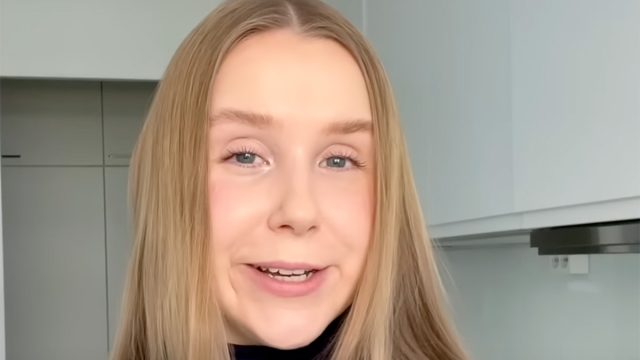Nutritionist Just Shared 4 Meal Prep Recipes for 100g Daily Protein
Struggling to hit your daily protein goals while juggling a busy schedule? You're not alone. Whether you're building muscle or simply trying to eat healthier, getting enough protein can feel like a full-time job. But recipe creator Selma (@Fitfoodieselma) has a solution that might make your life easier.
As someone diagnosed with IBS at 15, Selma has mastered the art of creating nutritious, gut-friendly meals that don't skimp on flavor. With over 3 million followers, she's known for sharing recipes that are both health-conscious and practical. In a recent post, she's sharing four protein-packed recipes that will help you reach 100g of protein daily. "I'm currently trying to build muscle, so aiming for 80-100g of protein," Selma shares.
Start Your Day with Apple Pie Protein Pancake Bowls
Transform your morning routine with these cozy fall-inspired pancake bowls. "I use high-protein Greek yogurt that contains 13 grams of protein per hundred grams," says Selma. The recipe combines eggs, protein-rich yogurt, and gluten-free flour, topped with fresh diced apples and cinnamon. "You could also use regular flour if you're not celiac, intolerant to gluten, or an IBS sufferer," Selma notes.
These pancake bowls are baked at 180°C (350°F) for about 25 minutes in greased glass containers or ramekins. "They are so fluffy and taste just like apple pie. A fun breakfast idea for fall," she adds. Selma typically preps four servings at a time, perfect for several days of protein-packed breakfasts.
Pack These Protein-Rich Noodle Soup Jars for Lunch
When the weather turns cold, Selma's noodle soup jars are the perfect portable lunch. "Now that the weather is getting colder, it's time to start making soups again," she shares. "You guys really like my noodle soup jars, so I'm making a new version of them."
The assembly is simple but strategic. Start with a homemade broth concentrate at the bottom: soy sauce, chili-infused olive oil, sesame oil, vegetable bouillon, and chili flakes. Layer in your protein source – Selma uses tofu, but notes "you could also use chicken, for example." Add thinly sliced broccoli heads ("so that they will cook quickly"), mushrooms, chopped bell peppers, quick-cooking rice noodles, and sugar snap peas.
Pro tip from Selma: "I take a jar to room temperature about 10 minutes before adding the hot water so that the glass won't break." Simply pour boiling water over the ingredients, stir, and wait five minutes for the noodles to cook. "Such a fun and easy meal," she adds.
Yourself to Healthy Protein Brownies
Who says you can't have brownies while hitting your protein goals? Selma's protein-packed brownies combine bananas, eggs, olive oil (though she mentions "you could also use coconut oil or melted butter"), almond flour, unsweetened cacao powder, and two scoops of vegan chocolate protein powder.
The secret to perfect protein brownies? "I sprinkle three pieces of 80% dark chocolate that I cut into chunks on top, but that's totally optional," Selma reveals. Baked at 180°C (350°F) for about 20 minutes, "these brownies are very moist, soft, chocolatey, and delicious."
End Your Day with Chicken Lentil Curry
For dinner, Selma combines lean protein with fiber-rich lentils in a flavorful curry. The magic starts with the marinade: "I mix together Greek yogurt, juice of two limes, curry powder, olive oil, salt, pepper, and chili flakes," she explains. After marinating the chicken for 30 minutes, it's cooked on a non-stick pan for about eight minutes.
The protein punch comes from both the chicken and lentils: "When the chicken is almost cooked, I add three diced bell peppers and one can of red lentils and stir," Selma says. She finishes the curry with low-fat cooking cream, though she notes, "You could also use light coconut milk." After simmering for 10 minutes and serving with rice, you've got what Selma calls "such an easy and tasty meal."
RELATED: Mum Lost 135 Pounds After Fixing These 6 Mistakes She Made Every Day
Tips for Successful Meal Prepping
Selma typically preps three days' worth of meals at a time, making four servings of breakfast and six servings of everything else. She emphasizes personalization in protein intake: "We are all different and need different amounts of food. It's recommended to eat between 0.8 – 2 grams of protein per kilogram of body weight, depending how active your lifestyle is."
Expert Take: How Much Protein Do You Really Need?
According to Harvard Health, protein needs vary significantly based on age, activity level, and health goals. The Recommended Dietary Allowance (RDA) for protein is 0.8 grams per kilogram of body weight, but this is just the minimum to prevent deficiency. For active individuals and those over 50, protein needs may increase to 1.2 to 1.5 grams per kilogram of body weight daily.
RELATED: PhD Nutritionist Reveals 3 Ways Women Over 35 Can Lose 15 Pounds and Look Younger
The Science of Protein Timing
Harvard Health experts stress that spreading protein intake throughout the day is more effective than consuming it all at once. They recommend consuming 15-25 grams of protein at each meal, which aligns perfectly with Selma's meal prep approach. This strategy helps maximize muscle protein synthesis and supports overall health goals.
All recipes are gluten-free and lactose-free, making them suitable for various dietary needs. Whether you're building muscle like Selma or simply trying to maintain a healthy diet, these protein-rich meal prep recipes offer a delicious way to reach your daily protein goals while saving time during the week. And if you enjoyed this article, take advantage of these 15 Quick Ways to Lose Body Fat Percentage in a Week.





